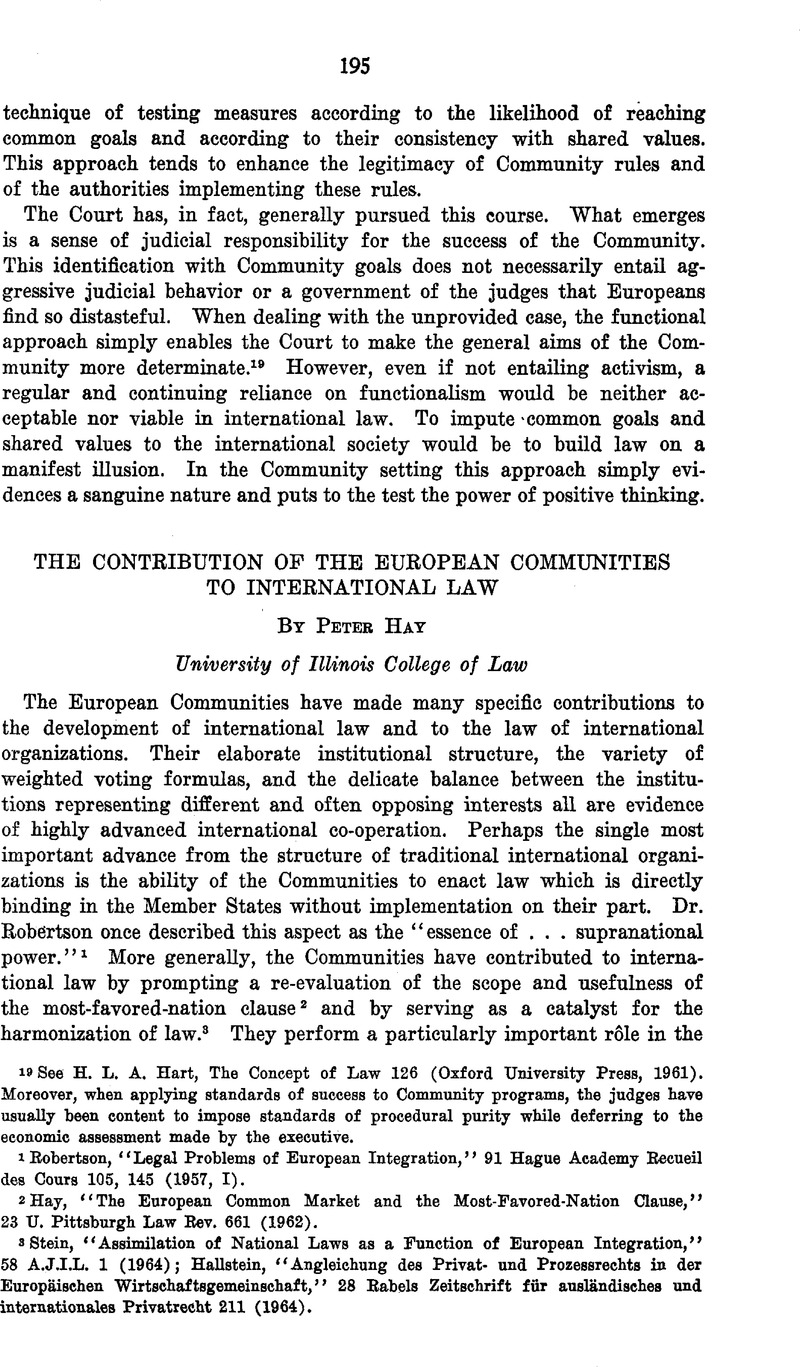Article contents
The Contribution of the European Communities to International Law
Published online by Cambridge University Press: 27 February 2017
Abstract

- Type
- Fourth Session
- Information
- Proceedings of the American Society of International Law at its annual meeting (1921-1969) , Volume 59 , 1965 , pp. 195 - 201
- Copyright
- Copyright © American Society of International Law 1965
References
1 Robertson, “Legal Problems of European Integration,” 91 Hague Academy Eecueil des Cours 105, 145 (1957, I ).
2 Hay, “The European Common Market and the Most-Favored-Nation Clause,” 23 U. Pittsburgh Law Eev. 661 (1962).
3 Stein, “Assimilation of National Laws as a Function of European Integration,” 58 A.J.I.L. 1 (1964); Hallstein, “Angleichung des Privat- und Prozessrechts in der Europaisehen Wirtschaftsgemeinschaft,” 28 Babels Zeitsehrift fur auslandisches und internationales Privatrecht 211 (1964).
4 Verdross, Volkerrecht 4 (3rd ed. 1955); “Eegles generates du droit international de la paix,” 30 Hague Academy Eecueil des Cours 275, 311 (1929,V).
5 Case 26-62, 9 Eecueil de la jurisprudence de la Cour 1 (1963) and Case 6-64, 10 ibid. 1143 (1964), respectively.
6 Ipsen, “Das Verhaltnis des Eechts der europaischen Gemeinschaften zum nationalen Eecht,” as reported by Eabe in 17 Neue Juristische Wochensehrift 1608, 1609 (1964).
7 1961 Journal Officiel des Communautes Europeennes 1274-1275. in the meantime, the Community itself has entered into trade relations with third countries. See the agreements with Iran (1963 Amtsblatt der Europaischen Gemeinschaf ten 2555), with Israel (Amstblatt of June 13 and August 15, 1964), the arrangements with the United States (436 TJ.N. Treaty Series 50; 445 Hid. 205; 446 Hid. 81), and the association agreements.
8 Arts. 96 E.C.S.C, 236 E.E.C, and 204 Euratom treaties.
9 Arts. 95(1) E.C.S.C, 235 E.E.C, and 203 Euratom (“special action”) treaties; Art. 95 (3-4) E.C.S.C (“little revision“) treaty; Art. 76 Euratom (amendment of the Supply Chapter) treaty.
10 See the Parliamentary Question (by Metzger) and the answer by the Commission in 1960 Amtsblatt der Europaisehen Gemeinschaften 1528. See also Becommendation of the Conference of the European Parliament with the African States and Madagascar, 1961 Amstblatt 942.
11 Jenks, “State Succession in Eespect of Law-Making Treaties,” 29 Brit. Yr. Bk. Int. Law 105 (1952); O'Connell, “Independence and Succession to Treaties,” 38 ibid. 84 (1962).
12 Everling, The Eight of Establishment in the Common Market 34 (1964); “Die Neuregelung des Assoziationsverhaltnisses zwisehen der Europaisehen Wirtschaftsgemeinschaft und den afrikanischen Staaten und Madagaskar sowie den iiberseeischen Landern und Hoheitsgebieten,” 24 Zeitschrift fiir auslandisches ofEentliches Eecht nnd Volkerrecht 472, 488-500 (1964).
13 See 1963 Amtsblatt der Europaisehen Gemeinschaften 1376, 1377, 1168; 1964 ibid. 463, 1174, 2105; and Parliamentary Question in 1962 ibid. 2601, 1963 ibid. 1875 (Vals).
14 See Friedmann, The Changing Structure of International Law, Ch. 1 (1964), and New York Times, March 13, 1965, pp. 29 and 37 (Economic Aid Problems).
- 1
- Cited by




